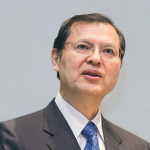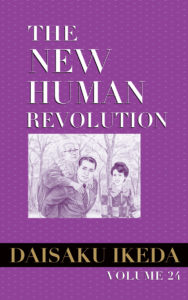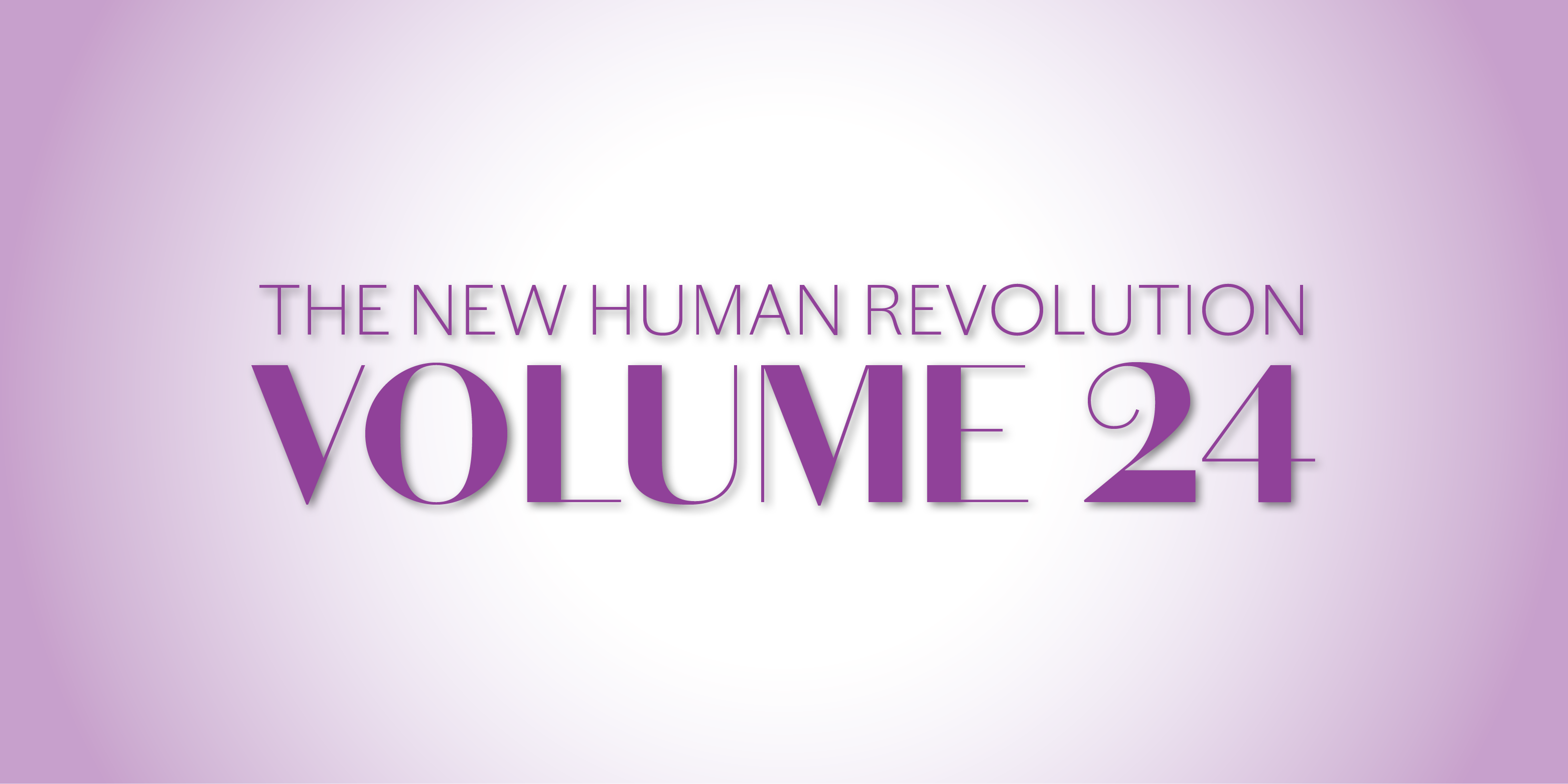 In the spirit of celebrating November 18, the Soka Gakkai’s founding day, members of the Byakuren Group, the training group for young women dedicated to supporting meetings and other Soka Gakkai activities, are currently engaged in their “Celebration Campaign” here in Japan, in which they are making great efforts to reach out to friends and expand their network of encouragement.
In the spirit of celebrating November 18, the Soka Gakkai’s founding day, members of the Byakuren Group, the training group for young women dedicated to supporting meetings and other Soka Gakkai activities, are currently engaged in their “Celebration Campaign” here in Japan, in which they are making great efforts to reach out to friends and expand their network of encouragement.
In a commemorative message for the group’s online gatherings, Ikeda Sensei expresses his hopes for them as follows: “No matter what happens, please continue to advance in high spirits and widen your circles of friendship, illuminating this century of The New Human Revolution with hearts that are as pure as the white lotus flower and lives that are a profusion of the greatest good fortune.”[1]
The “Vigilant Safeguarding” chapter in volume 24 of The New Human Revolution contains valuable guidance for youth division members taking part in such training groups, which also include the Soka Group and Gajokai for young men, to help deepen their understanding of the spirit behind these activities. Though these groups were formed during different periods of the Soka Gakkai’s history and under varying circumstances, they all seek to instill in youth the spirit of striving in Buddhist practice with the firm conviction that the Buddhas and bodhisattvas, and indeed all the protective functions of the universe, are fully aware of their efforts.
In other words, whether or not our actions are recognized by others, the efforts we make for kosen-rufu will undoubtedly manifest as good fortune and benefit in our lives. This is succinctly expressed in the following haiku composed by Shin’ichi Yamamoto for the Byakuren Group:
As they clean,
their actions shine
with Buddhahood.[2]
On October 1 this year, representatives of the Byakuren Group in Japan and Brazil (where it is called the Cerejeira or Cherry Blossom Group) held a joint meeting online, in which they reaffirmed the importance of taking personal initiative in any endeavor as well as the spirit of striving with the conviction that the Buddhas and bodhisattvas are aware of our actions, as discussed in the “Vigilant Safeguarding” chapter. It is heartening to see how these Buddhist values are taking root in the lives of our youth division across the world.
In the “Beacon” chapter, we find accounts of earnest efforts made by members of the business professionals, public housing and farming and fishing communities groups of the Soka Gakkai in Japan, all of which were established in October 1973. The world at that time had been thrown into a global recession triggered by conflict in the Middle East and the subsequent oil shock. Many countries were also suffering from severe food shortages due to extreme weather events. Amid these trying circumstances, the Soka Gakkai announced its annual theme for the following year, 1974, to be the Year of Society, which the members embraced, proud and confident in their mission as Buddhist practitioners to tackle society’s challenges head-on, find solutions and impart courage to others. They went on to greatly expand their network of trust in their workplaces and communities. In any age, the work of making Buddhism relevant and applicable to society is part of our mission, and engaging in our individual human revolution lies at the core of this.
The Soka Gakkai’s Buddhist Study Movement
Concerning the role of Buddhist study, the “Vigilant Safeguarding” chapter stresses:
Study needs to be rooted in daily life and serve as a guide for action. Study becomes a revitalizing force when it provides assurance and self-confidence in the power to overcome life’s difficulties and tribulations.[3]
Shin’ichi had been keenly aware of the need to reposition Nichiren Daishonin’s teachings so that each principle was understood from the perspective of religion existing for the sake of the people. This, he recognized, was a crucial step in making the teachings more accessible to people around the world. In order to strengthen the Soka Gakkai’s Buddhist study movement, he proposes that 1977 be the Year of Study and kicks off the year with a special lecture on the history of Buddhism at the Study Department General Meeting on January 15 in Osaka.
In the lecture, he touches upon the original roles of priesthood and laity and declares that in the present day it is the Soka Gakkai that is carrying out the functions of both. He also adds that based on Buddhist doctrine and the original purpose ascribed to Buddhist temples, the Soka Gakkai’s facilities can be seen as “contemporary temples,” in that they are serving the same functions. In the “Justice” chapter of volume 27 of The New Human Revolution, we learn that a group of Nichiren Shoshu priests interprets this lecture as criticism of them on the part of Shin’ichi, and uses it as ammunition against the Soka Gakkai.
In the October 12, 2020, issue of his article series “Daisaku Ikeda Studies,” published in the weekly Japanese magazine AERA, the Japanese writer Masaru Sato discusses this subject, noting that a group of Nichiren Shoshu priests began attacking the Soka Gakkai in 1977, giving rise to further arguments between the two sides. He observes that the disputes arose from their fundamental difference in perspective: the priesthood seeing themselves as superior to the lay believers, and the Soka Gakkai rejecting such a hierarchy and upholding the view of religion existing in service of the common person. Sato concludes that the Soka Gakkai’s separation from the priesthood was therefore inevitable in order for it to truly advance as a global religious movement.
I believe that the key to the Soka Gakkai’s development internationally has been our consistent emphasis on religion existing for the sake of humanity and our efforts to make Buddhist teachings relevant and applicable to our lives in the present.
Today, our Buddhist study movement has developed into a truly robust force throughout the world. Ikeda Sensei’s lecture series on the writings of Nichiren Daishonin, “The Buddhism of the Sun, Illuminating the World,” published in the Daibyakurenge, the Soka Gakkai’s monthly study journal, is studied by members in all our constituent organizations and serves as a driving force for our progress. Indeed, the philosophy of Nichiren Buddhism vibrantly exists in the lives of us ordinary members of the Soka Gakkai as a sure and sound philosophy. Let us never forget that this is a result of our mentor’s intense efforts throughout the years based on his conviction that “Buddhism, as a philosophy of hope responding to the needs of the times, should be revived in our modern-day society.”[4]
Unity Among Leaders
On October 18, I participated in an online discussion meeting held by members of Sunflower District on Shodoshima Island, Kagawa Prefecture. This virtual gathering—their first attempt at such an undertaking—was filled with joy, as many who had not previously been able to attend meetings were able to take part. Behind the meeting’s success were the efforts of the district leaders and other supporting leaders who kept in close communication, and while strictly adhering to the infection prevention guidelines, reached out to every member, visiting their home and offering encouragement.
In the “Humanistic Education” chapter, we read that one of the activity guidelines for 1977 was to strengthen the organization’s blocks (equivalent to today’s districts). To that end, Shin’ichi focuses on this frontline unit and encourages its leaders. “The most important thing is unity among those leaders,”[5] he shares, stressing that leaders must work together and encourage each member. He adds:
I want you to be my representatives and speak to them, listen to their problems, rally them, inspire them and warmly encourage them. Please think about what I would do as president of the Soka Gakkai, how I would encourage them and then strive to surpass me in that spirit.[6]
Shin’ichi repeatedly emphasizes the importance of encouragement. When we refer to strengthening each district, what we really mean is encouraging each and every member, for the “human heart is what drives everything.”[7]
Sensei concludes his editorial for the October 2020 issue of the Daibyakurenge with this short poem:
Encouragement, the jeweled light
illuminating a tiny corner of the world,
will ensure
the spirit of the Bodhisattvas of the Earth
endures into the eternal future.[8]
“The district is where we will fulfill our vow for kosen-rufu”—with this spirit, let us each make wholehearted efforts to encourage others, bringing our districts to shine as the light of hope for our communities.
Translated from the October 28, 2020, Seikyo Shimbun, the Soka Gakkai’s daily newspaper.
Summary of Contents
 Ode to Mothers
Ode to Mothers
In August 1976, the song “Mother” is completed. Shin’ichi Yamamoto shares precious memories of his mother.
Vigilant Safeguarding
Shin’ichi works to train members of the Gajokai, Soka Group and Byakuren Group (youth behind-the-scenes groups). He embarks on a series of lectures on Nichiren Daishonin’s writings, starting with “The True Aspect of All Phenomena.”
Humanistic Education
Shin’ichi attends various gatherings of local Soka Gakkai leaders. The education department holds various meetings including a major convention where teachers share their firsthand experiences.
Beacon
At numerous gongyo meetings, Shin’ichi gives guidance to the business professionals, public housing and farming and fishing communities groups.
This book is available at https://bookstore.sgi-usa.org.
You are reading {{ meterCount }} of {{ meterMax }} free premium articles

